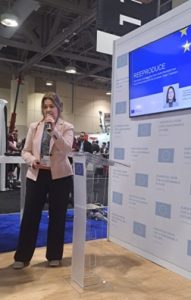10 Apr 2025
The REEPRODUCE project was present at PDAC 2025 in Toronto!

Since 1932, the World’s premier mineral exploration and mining convention is annually arranged in Toronto by the prospectors and developers’ association of Canada, PDAC. This year, it was held 2-5 March 2025, and brought together 27 000 attendees from over 135 countries for its educational programming, networking events, and business opportunities. The PDAC conference is the event of choice for the world’s mineral industry hosting more than 1 100 exhibitors and 700 presenters.
The European Commission (EC) was well represented at the PDAC in the EU booth at the conference exhibitors’ hall, where EU innovation solutions in the area of raw materials, and opportunities for cooperation in research and innovation were promoted. In this context, 19 projects financed by the EU were presented in the Auditorium at the EU booth, and REEPRODUCE was one of them. Ana Maria Martinez, coordinator of REEPRODUCE showcased the groundbreaking advancements and innovative solutions of the project. The presentation is available on the HaDEA website.
The EC, through its executive agency HaDEA, has contributed to the EU’s goal of securing a sustainable supply of raw materials by funding Horizon Europe projects, like REEPRODUCE. These research and innovation projects develop solutions for securing strategic value chains, through sustainable mineral exploration, extraction, processing and recovery of critical raw materials from waste streams.
REEPRODUCE is aiming to prove the economic and environmental sustainability of innovative concepts in rare earth elements (REE) recovery and production from end-of-life products at pilot scale levels (TRL7). The PDAC conference allowed not only clustering with other EU-financed projects represented at the EU booth, but networking with industrial stakeholders or potential investors who were interested to discuss the up-scale of the innovative technologies developed in the project towards pre-commercial (TRL8) and/or commercial plants (TRL9).
The establishment of a secure REE permanent magnets’ value chain is high on the agenda of the western world, and the recovery of permanent magnets from end-of-life products is recognised as an important step towards resource utilisation of one of the most critical raw materials, i.e., neodymium, praseodymium, dysprosium and terbium. Those REE are essential in the green and digital transition, as well as in defense applications.
Many methods are proposed to extract REE from permanent magnets in end-of-life products. The ones considered to be most robust are dealing with the recovery of the REE as oxides, which must be converted into metals before being cast into magnetic alloys. The metal conversion step is considered as the bottle neck in the establishment of a complete permanent magnets’ value chain in Europe and otherwise in the Western world. In this context, the high temperature electrolysis (HTE) process developed in REEPRODUCE attracted the attention of the PDAC attendees, especially those from Canada.
The advanced HTE technology developed by SINTEF can accommodate a mixture of RE oxides as feed, giving a RE alloy (REA) as product, which can be used in magnet manufacturing. Currently, RE oxide mixtures obtained after primary and/or secondary RE-containing resources are separated by energy intensive and environmetally
unfriendly extraction methods. Thus, REEPRODUCE’s HTE technology contributes to a more environmentally friendly and cost effective RE permanent magnet value chain. The innovative HTE technology developed in REEPRODUCE is flexible enough to be able to deal with RE oxide mixtures of different compositions as input material, without compromising the quality of the output metal product.
The fully automatised HTE cell is currently under construction, and it is expected to be ready for the first trials in June 2025 at Elkem premises in Fiskå, Norway.

Ana Maria Martinez, coordinator of REEPRODUCE, presenting the project in the auditorium of the EU booth.